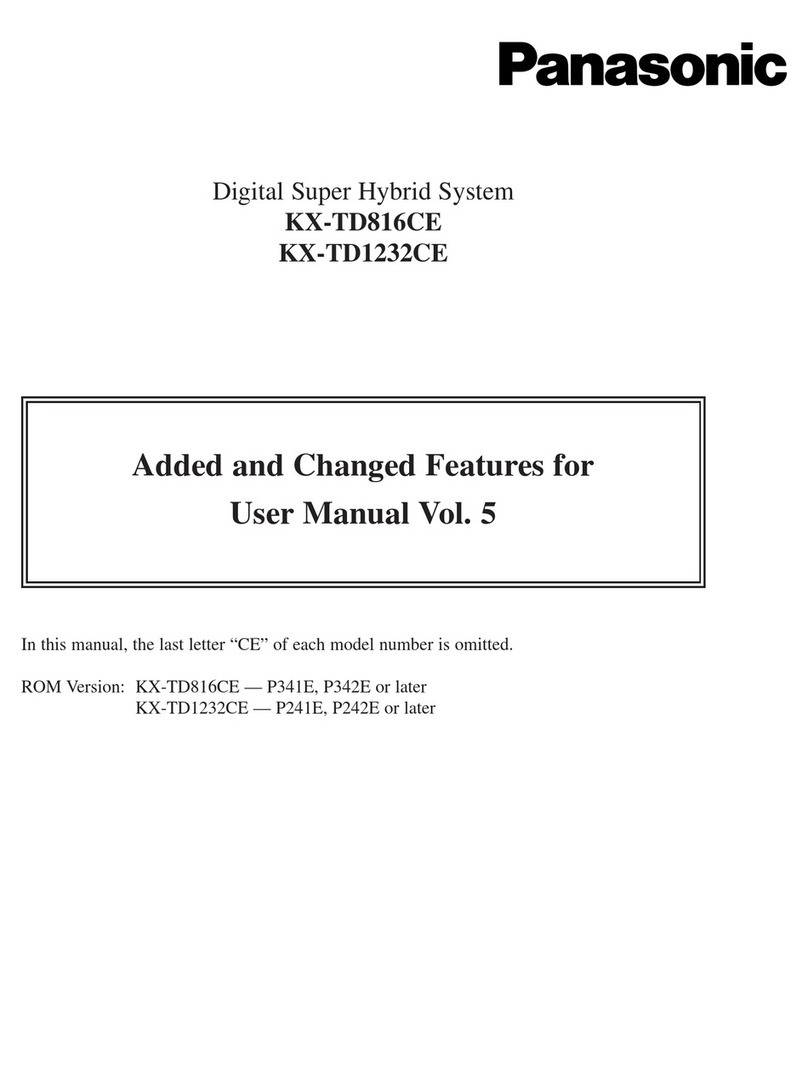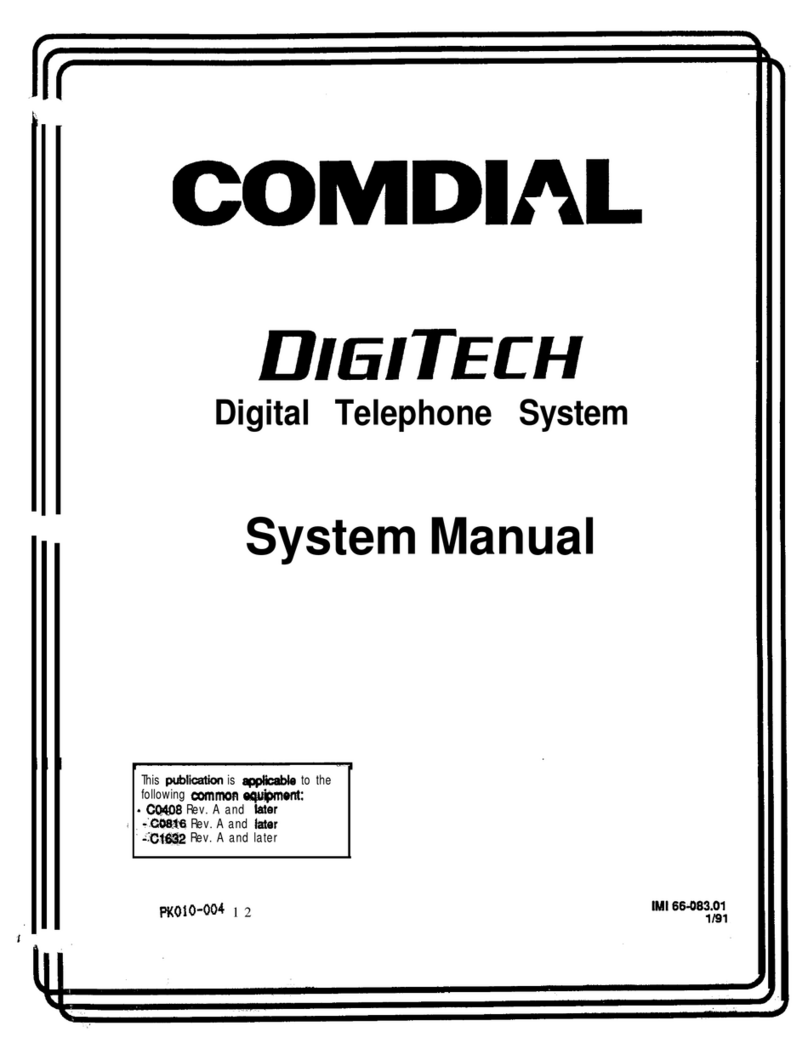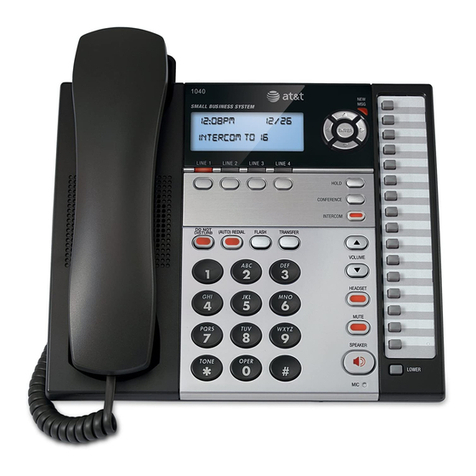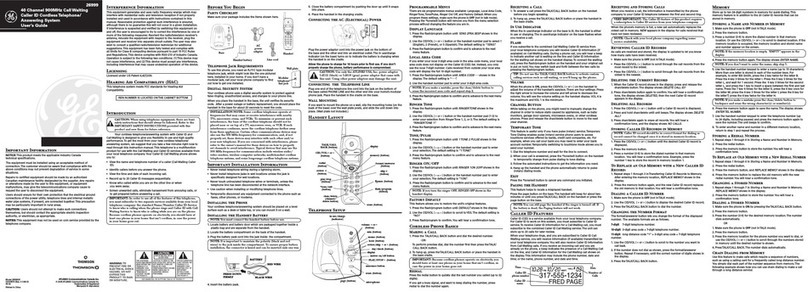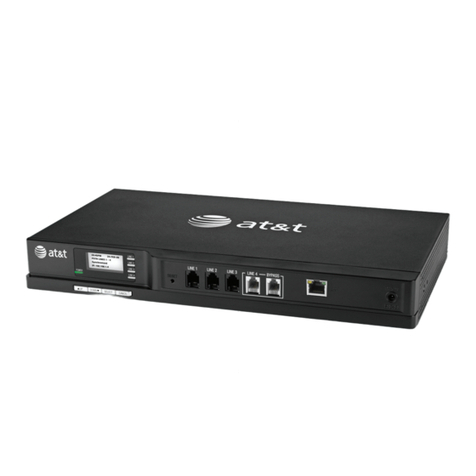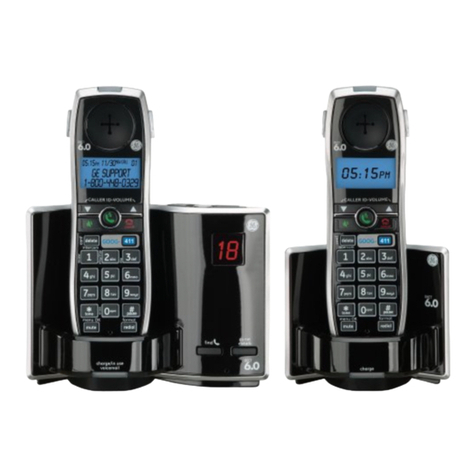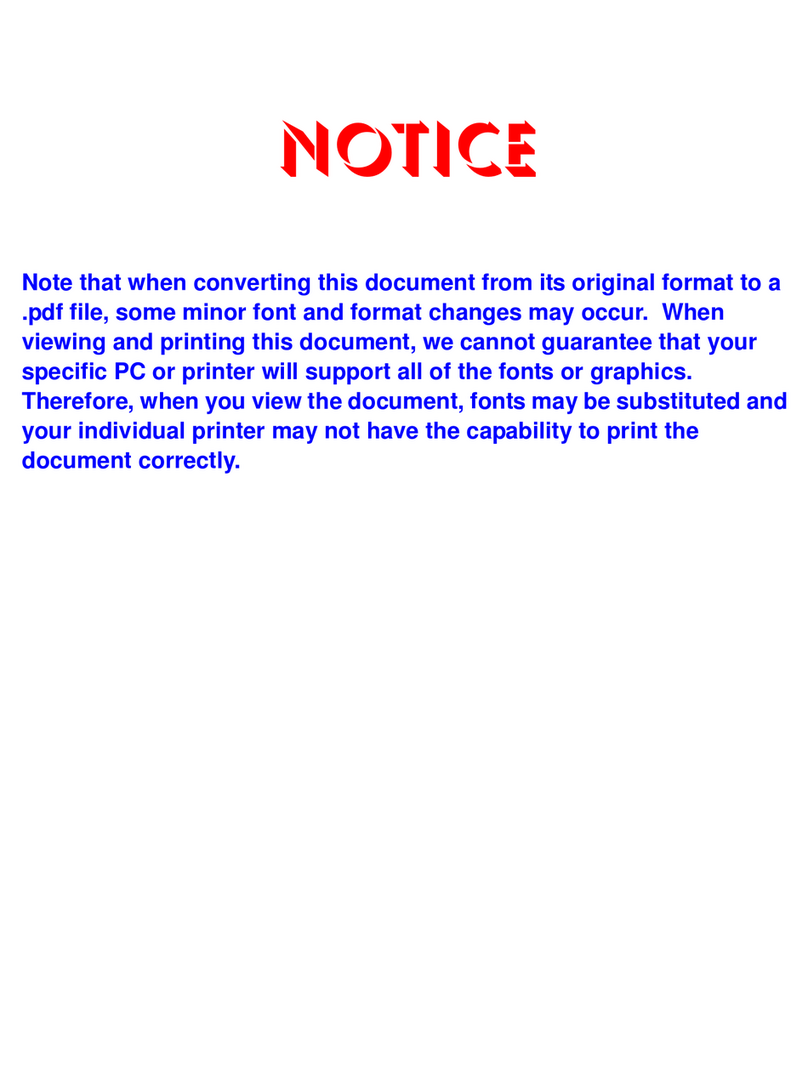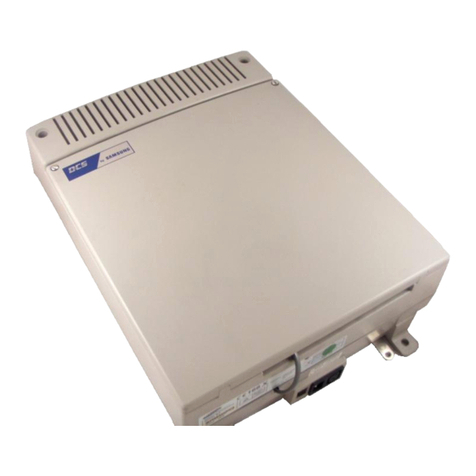Telesis PX24U User manual

PX24U
PX24M
HYBRID IP PBXs

IN BRIEF:
Thank yo
... for purchasing the Telesis PX24U/PX24M Hybrid IP PBX. It is anufactured to the
highest quality standards and tested vigorously to co ply with require ent for its
product specifications.
In this anual, you will find basic infor ation about the PX24U/PX24M and quickly
setting it up. We hope that this si plified anual will get you started and help you
fa iliarize with your new hybrid IP PBX syste .
For the appropriate operation of your new hybrid IP PBX, it ay need progra ing
and/or licensing. Please contact your local Telesis Dealer for details.
We hope that your PX24U/PX24M Hybrid IP PBX will serve you well and provide
you with all your co unication needs now and in the future.
PX24U/PX24M in Brief
Offering traditional and IP connections in one syste , PX24U/PX24M syste s are
suited for SMEs wishing to igrate to IP PBX syste s while keeping traditional TDM
interfaces. There are analog subscribers and trunks, all featured with caller ID, as well
as 48 Vdc feed for analog subscribers to drive long loops. Solution also offers 2-wire
digital subscribers, Euro ISDN BRI (S0/T0, Uk0) ports, as well as SIP and H.323
support/integration. Integrated digital voice recorder has 100 hr capacity.
PX24U/PX24M Package
Depending on your syste specifications, co ponents that co e with your order ay
vary, please check your shipping list for a full description of what was included in your
package.
Hardware: Digital phones
The PX24U/PX24M ay be with optional digital phones. These ay also be used as
operators consoles.
Software: Xymphony
Inside the control and switching odule there is a processor that controls all the tasks
related to the syste such as switching, signaling and voice essages. An operating
software (or fir ware) called Xy phony runs inside this processor. The operating
software Xy phony co es installed at the factory but it can also be upgraded in the
field.
3

PX24U: Small Capacity Hybrid IP PBX
The PX24U Hybrid IP PBX is the s allest capacity syste in the PX24 fa ily. It is an
ideal Business Phone Syste for s all enterprises and businesses, wishing to igrate
to IP PBX syste s with keeping the traditional TDM interfaces.
Each PX24U Hybrid IP PBX syste co es with the following STANDARD hardware
and software features:
•Xy phony operating fir ware
•4 analog DC loop trunks (i.e., CO trunks or FXO ports)
•4 digital subscriber ports
•12 analog subscribers (FXS ports)
•Caller ID encoders (trans itters)
•Caller ID decoders (receivers)
•12 or 16 kHz charge pulse detectors for analog DC loop trunks
•Polarity reversal detection on analog DC loop trunks
•DTMF transceivers
•Conference hardware
•Integrated CMDR (call records) buffer
•Integrated DVR (digital voice recorder) with 100 hours capacity
•4 playing and 4 recording channels for the DVR
•Personal conversation recording capability
•Integrated Voice Mail (VMail)
•Integrated Auto atic Call Distributor
•Integrated Signaling / Protocol Analyzer
•Integrated Web server (in various languages like Czech, English, French,
Georgian, Polish, and Turkish)
•Integrated API server for unli ited nu ber of Clients
•Integrated H.323 gatekeeper for 160 H.323 VoIP users
•Integrated SIP registrar for 160 SIP VoIP users
•Integrated Telesis xSIP (eXtended SIP) registrar for nu erous xSIP VoIP users
•AC-DC power converter
•Integrated 48 VDC Battery charger
•Installation accessories
•Hundreds of supple entary services for analog, digital and VoIP users
4

PX24U owners ay also benefit the following OPTIONAL hardware and software
features:
•19inch rack-adapters to install the PX24U into industry standard 19inch racks
•Telesis digital sets, which can connect to the digital subscriber ports over a
single pair of wires
•Telesis xSIP VoIP phones
•Telesis xSIP VoIP softphones
•Licenses for IP-to-TDM and TDM-to-IP gateway channels, which allow call
routing between TDM and IP (SIP, H.323) users
•Licenses for xSIP VoIP phone users
•License for AES-256 encryption for VoIP calls
•Licenses to expand playing and recording channels in the integrated DVR
•Licenses for auto atic voice (conversation) recording on preselected TDM
ports
The Telesis PX24U Hybrid IP PBX provides hundreds syste features, syste
para eters, and user services. If it is desired, these ay be activated or deactivated.
With these progra able features and services, the PX24U ake traffic anage ent
highly efficient and versatile. The convenience of dealing with all-in-one syste
software Xy phony allows the user to support as any features as desired, up to the
axi u capacity. Another aspect of the syste `s software is an advanced algorith
for creating routing tables.
Many of the user services are applicable for SIP calls with using the basic SIP
supple entary services such as Invite (call hold), call forward and call transfer (with
refer ethod). Si ilarly, these are also applicable for H.323 calls with using the basic
H.450 supple entary services.
Further ore, Telesis proprietary xSIP (eXtended SIP) protocol allows value added
services of the DTS digital telephone sets also to be functional over IP.
For ensuring the easy and fast progra ing of the PX24U, each progra able
para eter is set to a default value. The standard default values are carefully selected
and opti ized for a wide range of custo ers` require ents. Thus, the flexibility does
not bring a co plexity.
PX24M: Medi m Capacity Hybrid IP PBX
The PX24M Hybrid IP PBX is the ediu capacity syste in the PX24 fa ily. It is
an ideal Business Phone Syste for s all and ediu enterprises and businesses,
wishing to igrate to IP PBX syste s with keeping the traditional TDM interfaces.
Each PX24M Hybrid IP PBX syste co es with the following STANDARD
hardware and software features:
•Xy phony operating fir ware
•4 analog DC loop trunks (i.e., CO trunks or FXO ports)
•4 digital subscribers
•16 analog subscribers (FXS ports)
•Caller ID encoders (trans itters)
•Caller ID decoders (receivers)
•12 or 16 kHz charge pulse detectors for analog DC loop trunks
•Polarity reversal detection on analog DC loop trunks
•DTMF, MFR1, MFCR2 transceivers
•HDLC circuits for optional BRI ISDN card
5

•Conference hardware
•Integrated CMDR (call records) buffer
•Integrated DVR (digital voice recorder) with 100 hours capacity
•4 playing and 4 recording channels for the DVR
•Personal conversation recording capability
•Integrated Voice Mail (VMail)
•Integrated Auto atic Call Distributor
•Integrated Signaling / Protocol Analyzer
•Integrated Web server (in various languages like Czech, English, French,
Georgian, Polish, and Turkish)
•Integrated API server for unli ited nu ber of Clients
•Integrated H.323 gatekeeper for 160 H.323 VoIP users
•Integrated SIP registrar for 160 SIP VoIP users
•Integrated Telesis xSIP (eXtended SIP) registrar for nu erous xSIP VoIP
users
•AC-DC power converter
•Integrated 48 VDC battery charger
•Installation accessories
•Hundreds of supple entary services for analog, digital and VoIP users
•TWO EXPANSION SLOTS
PX24M owners ay also benefit the following OPTIONAL hardware and software
features:
•19inch rack-adapters to install the PX24U into industry standard 19inch racks
•Telesis digital sets, which can connect to the digital subscriber ports over a
single pair of wires
•Telesis xSIP VoIP phones
•Telesis xSIP VoIP softphones
•Licenses for IP-to-TDM and TDM-to-IP gateway channels, which allow call
routing between TDM and IP (SIP, H.323) users
•Licenses for xSIP VoIP phone users
•License for AES-256 encryption for VoIP calls
•Licenses to expand playing and recording channels in the integrated DVR
•Licenses for auto atic voice (conversation) recording on preselected TDM
ports
•Expansion cards
The Telesis PX24M Hybrid IP PBX provides hundreds syste features, syste
para eters, and user services. If it is desired, these ay be activated or deactivated.
With these progra able features and services, the PX24M ake traffic anage ent
highly efficient and versatile. The convenience of dealing with all-in-one syste
software Xy phony allows the user to support as any features as desired, up to the
axi u capacity. Another aspect of the syste `s software is an advanced algorith
for creating routing tables.
Many of the user services are applicable for SIP calls with using the basic SIP
supple entary services such as Invite (call hold), call forward and call transfer (with
refer ethod). Si ilarly, these are also applicable for H.323 calls with using the basic
H.450 supple entary services.
Further ore, Telesis proprietary xSIP (eXtended SIP) protocol allows value added
services of the DTS digital telephone sets also to be functional over IP.
6

SOME HARDWARE AND SOFTWARE DETAILS
MEMORIES
The non-volatile (NV) type e ories in the Telesis PX24U/PX24M Hybrid IP
PBX are used for storing:
• Boot progra ,
• Operational software Xy phony,
• Progra ed para eters,
• Voice records (100 hours),
• CMDR call records (tens of thousands of call records), and
•Syste records.
NV e ories are solid state integrated circuits and never loose data in case of
power failures even for a long period of ti e.
Volatile e ories (RAMs) are used for running the operational software
(fir ware) Xy phony within the PX24U/PX24M Hybrid IP PBX.
ETHERNET INTERFACES
10/100 BaseT ethernet interfaces on Telesis PX24U/PX24M Hybrid IP PBX Syste s
provide nu erous IP Telephony applications and syste anage ent solutions. So e
of these are:
•Web based syste anage ent
•CMDR (detailed call records) collection
•Syste alar and warning essages collection
•Statistics data collection
•Voice (conversation) records collection
•Xy phony API server and client co unication
•H.323 protocol support with H.225.0 version 5, H.235 version 3 H.245 version 12,
H.450, AES FIPS PUB 197. Connections between the syste and H.323 entities.
•SIP Session Initiation Protocol support with RFC 3261. Connection between the
syste and SIP entities.
•xSIP (eXtended SIP). Connection between the syste and xSIP ter inals
INTEGRATED AUTOMATIC VOICE RECORDER
Auto atic voice recording of all calls (conversations) is critical to so e operations and
installations such as;
1.Public Safety and Health
2.Call Centers
3.Air, Mariti e, Railway Traffic Control
The integrated DVR (digital voice recorder) within Telesis PX24U/PX24M Hybrid IP
PBX Syste s ay be used in such operations and applications for bi-directional (both
calling and called party voices) recording. The co bination of the integrated DVR
hardware (with a storage capacity of 100 hours or ore) and a PC running XPort Utility
is the heart of this solution. In this solution, the integrated DVR operates as recording
buffer, whereas the PC with XPort is the ain archiving device.
SOFTWARE
Telesis PX24U/PX24M Hybrid IP PBX is a Stored-Progra -Controlled (SPC) syste .
Its leading-edge operational software, Xy phony, has been developed by Telesis
specifically for this switching syste . A ong the any aspects of Xy phony is its
advanced algorith for creating routing tables, co plete with options for Least-Cost
Routing (LCR), real-ti e charging tables, and various subscriber/trunk classes.
With any progra able features, Xy phony akes the traffic anage ent highly
efficient and versatile. The convenience of dealing with all-in-one standard software
allows the user to support as any features as desired, up to the axi u capacity:
thus, an organization's capacity can grow without necessarily updating the software.
Upgrading the Xy phony operating syste in the field is acco plished si ply by
downloading a new version of it directly onto the PX24U/PX24M Hybrid IP PBX's
solid state disc over IP without interruption to any of the syste 's services.
Xy phony within the PX24U/PX24M Hybrid IP PBX Syste is odular and well
structured and is developed by a high level language of C.
7

Xy phony also provides:
•easy expansion and odification when introducing new services and technologies, to
guarantee high reliability,
•introduction procedures for new software parts or repairs with ini u service
interruptions. Software repairs are nor ally introduced without any loss of answered
calls. New software packages are introduced with a ini u service interruption,
independent of the size of the switching syste , to provide well defined procedures for
collecting of infor ation, restoring to nor al operation and introduction of repairs in
case of disturbances caused by so e errors.
The PX24U/PX24M Hybrid IP PBX syste verifies the integrity of its software at
regular basis.
TRAFFIC-HANDLING CAPACITY
The PX24U/PX24M Hybrid IP PBX e ploys a fully non-blocking switching atrix.
The advanced design incorporates state-of-the-art Digital Signal Processors that are
capable of executing illions of instructions a second. Such highly efficient use of the
syste 's resources, with the help of intelligent algorith s, leaves no possibility that an
overload condition will arise.
The PX24U/PX24M Hybrid IP PBX allows hundreds of H.323 endpoints to be
registered into its integrated gatekeeper. These endpoints ay be IP trunk routes and/or
H.323 hard/soft phones with their own IP addresses. Further ore, the PX24U/PX24M
Hybrid IP PBX can register to ultiple gatekeepers si ultaneously. For an IP to IP
call, the edia is direct fro an H.323 endpoint to another, such a call does not use a
syste channel resource (i.e., PCM channel fro the switching atrix). The
PX24U/PX24M Hybrid IP PBX provides the address resolution and so e others
services according to the predefined profile of every registered endpoint. For such
calls, the PX24U/PX24M Hybrid IP PBX acts as a s all softswitch. There can be any
nu ber of si ultaneous IP to IP, H.323 calls.
The PX24U/PX24M Hybrid IP PBX allows hundreds of SIP user agents to be
registered into its integrated registrar. These endpoints ay be IP trunk routes and/or
SIP hard/soft phones with their own IP addresses. Further ore, the PX24U/PX24M
Hybrid IP PBX can register to ultiple registrar si ultaneously. For an IP to IP call,
the edia is direct fro a SIP user agent to another, such a call does not use a syste
channel resource (i.e., PCM channel fro the switching atrix). For such calls, the
PX24U/PX24M Hybrid IP PBX acts as a s all softswitch. There can be any nu ber of
si ultaneous IP to IP, SIP calls.
Ports or interfaces ay be:
•blocked both-way calls
•blocked for inco ing calls only
•blocked for outgoing calls only
anually.
CALL ROUTING CAPABILITIES
The advanced routing algorith within the Telesis PX24U/PX24M Hybrid IP PBX
syste is carried out in four steps:
•First Step: Inco ing A-Party Analysis,
•Second Step: B-Party (called-party) Pre-Analysis
•Third Step: B-Party (called-party) Main Analysis
•Fourth Step: Outgoing A-Party Analysis
The sa e routing algorith is applied for both TDM and VoIP calls
Incoming A-Party Analysis (optional):
Inco ing A-Party (calling-party) analysis is the first (optional) step in Routing
Analysis. It is applied to each originating or inco ing interface. In order to facilitate
this analysis, an inco ing A-party analysis table is assigned to the originating user
(TDM or VoIP). The inco ing A-party analysis is done by analyzing the calling-party's
Nu ber (up to 32 digits), Category, Nature of Address (or type of nu ber), Nu bering
Plan, Presentation Status, Screening Status, etc. after which any or all of these
para eters ay be translated and then selected for a called-party pre-analysis table.
Called-Party Pre-Analysis (optional):
The Pre-Analysis is carried out prior to the ain called-party analysis to truncate so e
called-party prefixes or reject certain addresses (destinations) altogether. Telesis has
developed pre-analysis in order to si plify the ain analysis, especially for when a
Telesis X1 syste services several operators in transit ode. Pre-analysis is applied to
as any as 16-digit called-party prefixes.
8

Main Analysis:
The ain called-party analysis is carried out on the called-party prefixes resulting fro
the pre-analysis. Up to 16-digit-long prefixes ay be analyzed. It is possible to define
the ini u and axi u digits for starting the analysis. This analysis is date- and
ti e-dependent, i.e., for different days of the week and different ti es of the day, the
analysis ay result in different outco es:
•Route
•Called-party nu ber replace ent (up to 32 digits)
•Call class to be used for detailed CMDR
•Authorization level necessary to realize the routing
•Tariff
The route that is decided on after this analysis ay be:
•A local ter ination (i.e., subscriber)
•A trunk group fro which the call is to be routed outward
•A physical address of a digital/analog subscriber/trunk port available in the switch
•A re ote H.323 gatekeeper
•A re ote SIP registrar
•A subscriber service
•A syste service for aintenance and ad inistrative purposes
•A syste resource like integrated voice ail, essage-storage hardware etc.
•A tone or a syste essage stored in the switch
O tgoing A-Party Analysis (optional):
Outgoing A-party (calling-party) analysis is the last (optional) step in the routing
procedure. It is applied to the ter inating or outgoing interface. In order to facilitate
this analysis, an outgoing A-party analysis table is assigned to the called
subscriber/outgoing trunk. The outgoing A-party analysis is done by analyzing the
calling party's nu ber (up to 32 digits), Category, Nature of address, Nu bering Plan,
Presentation Status, Screening Status, etc. and, additionally, the Called-Party's Nature of
Address, after which any or all of these para eters ay be translated.
SYSTEM MANAGEMENT AND BILLING
The Telesis PX24U/PX24M Hybrid IP PBX can anaged over IP. Syste progra ing
and updating the Xy phony operating syste can easily be anaged either on site or
re otely, through a WEB browser connection to web server integrated into the syste .
All syste - anage ent operations are perfor ed without interrupting the functions of
the syste . The integrated web server allows:
•Subscriber ad inistration
•Routing ad inistration
•Trunk-circuit ad inistration
•Call-charging ad inistration
Further ore, the Telesis XPort utility allows:
•Detailed onitoring of signaling
•Traffic easure ent including collecting detailed call-data records
•Downloading conversation records
A powerful feature of Xy phony concerns call charging. It is capable of prefix digit
analysis of up to 16 digits. Destination-based tariff tables can be constructed to define:
•Unit-charge periods depending on destination
•Unit-charge periods depending on the day of the week and ti e of day
•Vacations and other special days for separate unit-charge periods
•Fixed-charge calls
•Charge-free calls
All unit-charge periods are specified in ultiples of 100 sec ( illiseconds). Hence, a
unit-charge period ay take a value fro 100 sec to several inutes in ultiples of
100 sec. Further ore, call-charging infor ation generated by far-end equip ent can
also be used.
A subscriber service (such as call forwarding, re inder) can have a separate fixed fee
charge for using, activating, deactivating, or querying the service.
Call charging is processed in real ti e during the call. Pre-paid status within a certain
a ount of credit can be defined for each subscriber.
9

A detailed record for each call and service use ay be generated by Xy phony
(operating fir ware of the X1) and is trans itted to Telesis XPort Software Utility
(running on the aintenance or billing PC). Each record in the database holds details
of a call, including:
•sequence nu ber
•type of record
•date and ti e of the record generated within the Telesis syste
•duration of the call in the record
•port access code (address), which is to be billed
•port access code, which ade a password protected call
•outgoing port or the called port address
•digits received fro the originating port
•replaced digits after routing analysis for an outgoing call
•password for a password protected call
•ti e of alar indication for a wake up call
•calling party nu ber for an inco ing call
•nu ber of the calling party
•total nu ber of charge pulses received (real charge pulses)
•total nu ber of locally generated charge pulses (pseudo charge pulses)
•channel infor ation for CCS signalling ports
•reference nu ber of the call
•switching syste 's na e
•services used for the call like Last nu ber redial, Dial fro user pool, Dial by
special key, Syste controlled hot line, User controlled hot line, Redial in
inco plete, Redial destination busy, Alerting ti eout, No infor ation, User
controlled call forwarding (BRI ISDN), User controlled unconditional call
forwarding, User controlled call forwarding busy, User controlled call forwarding
no reply, Syste controlled unconditional call forwarding, Syste controlled call
forwarding busy, Syste controlled call forwarding no reply, Call tranfer after
answer, Call back, User controlled divert routed call, Call transfer while the
destination is busy, Call transfer while the destination is ringing, Alternative
routing
XPort can send call records to a printer or a text file in a user-defined line for at.
The PX24U/PX24M Hybrid IP PBX has no hardware parts that require periodic
aintenance. However, the call data accu ulated in the PX24U/PX24M Hybrid IP
PBX's solid state disc should periodically be downloaded through XPort to its database
to create space on the syste 's disc.
SYSTEM AND USER SERVICES
Telesis PX24U/PX24M Hybrid IP PBX syste s provide, at least, syste features,
syste para eters, and user services, described below. If it is desired, these ay be
activated or deactivated.
Many of the user services, entioned below, are applicable for SIP calls with using the
basic SIP supple entary services such as Invite (call hold), call forward and call
transfer (with refer ethod). Si ilarly, these services are also applicable for H.323
calls with using the basic H.450 supple entary services.
For ensuring the easy and fast progra ing of the PX24U/PX24M Hybrid IP PBX,
each progra able para eter is set to a default value. The standard default values are
carefully selected and opti ized for a wide range of organizations' require ents. Thus,
the flexibility does not bring a co plexity.
Access code
Accessible while alerting
Account code
Account na e
Advice of charge coefficient
Advice of charge coefficient as divider
AES-256 edia encryption
Alerting essage
Alerting transfers do not clear
Alternative routes
Alternative route causes
Alternative ACD syste essages
10

Always try to seize first port
ANI (auto atic nu ber identification)
Any IP address can register
A-Party (calling party) analysis
Analog trunk to trunk connects
Answer ca ped call
Attendant positions
Authorization odified tone
Authorization odified tone cadence odification
Authorization odified tone frequencies odification
Authorization odified tone level odification
Auto dialing
Auto dialer frequencies for detection
Auto atic attendant
Auto atic Call Distribution ACD
B-Party (called party) analysis
Boot Xy phony
Busy transfers do not clear
Busy essage
Busy essage download
Busy essage re ove
Busy essage upload
Busy tone
Busy tone cadence odification
Busy tone frequencies odification
Busy tone level odification
Call back
Call center
Call class
Call forwarding busy
Call forwarding no reply
Call forwarding unconditional
Call hold
Call hold disabled
Call intrusion
Call intrusion authorization
Call park
Call pickup
Call resu e
Call routing
Call status
Call suspend
Call transfer
Called party (B-Party) analysis
Called party nu bering plan
Caller ID
Calling party (A-Party) analysis
Calling party filtering
11

Calling plans
Ca p on
Ca p on if no channel
Ca p on tone
Ca p on tone cadence odification
Ca p on tone frequencies odification
Ca p on tone level odification
Ca p on with alerting tone
Ca p on with busy tone
Charge pulse li it per call
Charge pulse on answer
Charge pulse on connection
Charge pulse period
Clear held calls
CMDR (Call Message Detailed Record)
Co on pool edit
Conference
Confir ation tone
Confir ation tone cadence odification
Confir ation tone frequencies odification
Confir ation tone level odification
Copy routing table
Copy user properties
Credited extension
Credit edit
CTI (co puter telephony integration)
DDI (direct dialing in)
Declare external IP address (for H.323)
Declare external IP address (for SIP)
Default ax-forwards
Default Xy phony
Delayed digits as DTMF
Delayed hot line
Delayed hot line tone
Delayed hot line tone cadence odification
Delayed hot line tone frequencies odification
Delayed hot line tone level odification
Dial tone
Dial tone cadence odification
Dial tone frequencies odification
Dial tone level odification
Dial fro user pool
Dial fro co on pool
Dial fro directory
DID (direct inward dialing)
Directory
DISA (direct inward syste access)
Divert routed calls
12

Diversion active tone
Diversion active tone cadence odification
Diversion active tone frequencies odification
Diversion active tone level odification
DNS server IP address
Do not disturb
Do not disturb activation
Do not disturb deactivation
DVR (digital voice recorder)
Enable advice of charge identifier
Enable connected nu ber identifier
Enable pending call warning
Enable progress indicator
Forced release
Force trans it edia fra e length
G.168-2 echo canceler
G.711 codec
G.711 trans it buffer length
G.711 preferred receive buffer
G.711 trans it silence suppress
G.723 codec
G.723 trans it buffer length
G.723 trans it silence suppress
G.723 trans it 6.4kbps co press
G.723 preferred receive buffer
G.723 receive ask for suppress
G.729 codec
G.729 trans it buffer length
G.729 trans it silence suppress
G.729 preferred receive buffer
Gateway IP address
Gateway external IP address
H.323 protocol
H.323 gatekeeper identifier
H.323 RAS ulticast port UDP
H.323 unicast port UDP
H.323 call signaling port TCP
H.245 ter inal type
H.450 supple entary services
Hold essage
Hold essage download
Hold essage re ove
Hold essage upload
Hot line
Howler tone
Howler tone cadence odification
Howler tone frequencies odification
Howler tone level odification
13

Ignore checksu in signaling (for H.323)
Ignore checksu in signaling (for SIP)
Ignore declared IP addresses
Inco ing call only
Inhibit call transfer warning
IP address (syste )
ISDN supple entary service 3-PTY
ISDN supple entary service AOC-D/E
ISDN supple entary service CCBS
ISDN supple entary service CCNR
ISDN supple entary service CFU
ISDN supple entary service CFNR
ISDN supple entary service CLIP
ISDN supple entary service CLIR
ISDN supple entary service COLP
ISDN supple entary service COLR
ISDN supple entary service ECT
ISDN supple entary service DDI
ISDN supple entary service HOLD
ISDN supple entary service MCID
ISDN supple entary service MSN
ISDN supple entary service UUS
Last nu ber redial
LCR (least cost routing)
Local call ring type1 tone
Local call ring type2 tone
Local call ring type3 tone
Local call ring type4 tone
Local call rings cadence odification
Local call ring tones cadence odification
Local call ring tones frequencies odification
Local call ring tones level odification
Lower algorith s disabled
Malicious call trace
Media jitter buffer
Melody co poser
Message waiting
Message waiting by alerting
Message waiting callback
Multi station call
Multiple entry tone
Multiple entry tone cadence odification
Multiple entry tone frequencies odification
Multiple entry tone level odification
Multiple hold tone
Multiple hold tone cadence odification
Multiple hold tone frequencies odification
Multiple hold tone level odification
14

Music on hold
MWI ( essage waiting indicator)
Night service
No authorization check for co on pool
Non discri inative ringing
No route if CMDR buffer is full
Outgoing call only
Overflow tone
Overflow tone cadence odification
Overflow tone frequencies odification
Overflow tone level odification
Override charge pulse li it
Para eter store
Park essage
Password login
Password update
Per itted call class
Port route
Port status
Records not reported
Redial on alerting ti eout
Redial on destination busy
Redial on inco plete dialing
Reject diverted calls
Reject diverted calls activation
Reject diverted calls deactivation
Re inder essage
Re inder essage download
Re inder essage re ove
Re inder essage upload
Re inder service
Re inder service activation
Re inder service deactivation
Re inder service tone
Re inder sequence
Re ote port to send essages
Registrar/Gatekeeper type
Roo house keeping
Roo report
Roo occupancy
Roo query
Routed call pickup
RTP ToS-Diffservices
Runti e status of the syste
Secondary dial tone
Secondary dial tone cadence odification
Secondary dial tone frequencies odification
Secondary dial tone level odification
15

Security profile
SIP (session initiation protocol)
SIP supple entary services
SIP UDP signaling port
Single port routing
Speed dial e ory
Statistics period
Subnet ask
Suspended calls cleared
Syste language
Syste na e
Syste daylight saving
Syste ti e
Syste ti e zone
Syste para eter upload
Tie line
Trunk call ring tone
Trunk call ring cadence odification
Trunk call ring tone cadence odification
Trunk call ring tone frequencies odification
Trunk call ring tone level odification
Upload Xy phony
User authorizations
User para eter upload
User pool
User pool update
Use rport in invite essage
User service charges
Vacant tone
Vacant tone cadence odification
Vacant tone frequencies odification
Vacant tone level odification
VMail (Voice Mail)
Voice ail quota full essage
Voice ail quota full essage download
Voice ail quota full essage re ove
Voice ail quota full essage upload
Voice ail receive
Voice ail receive essage
Voice ail receive essage download
Voice ail receive essage re ove
Voice ail receive essage upload
Voice ail send
Voice ail send essage
Voice ail send essage download
Voice ail send essage re ove
Voice ail send essage upload
Voice essage on alerting
16

Voice essage on setup
Voice essage play
Voice essage quota for user
Voice essage recording
Voice essage set switch
VoIP route call capacity
Wake-up service
Web server
Web server login ID
Web server para eters reset
Web server password
Web server http port
Welco e essage
Welco e essage download
Welco e essage re ove
Welco e essage upload
XCo API client utility integration
XMan utility integration
XPort utility integration
xSIP (eXtended SIP) Protocol
Xy phony operating syste
Xy phony API client support
Xy phony API signaling port
Xy phony API server
TONES
The tones are applied to infor the subscriber about different states of the subscriber
line, network situations or events in the call set-up phase, during conversation or when
subscriber procedures are used to activate, deactivate, interrogate or invoke a
subscriber service. The tones are applied in confor ity with ITU-T Reco endation
Q.35. The levels of the tones are stated in dB 0 at the exchange in which the tone is
inserted. The har onic distortion of all tones is <1%. The accuracy of the ti ing is
better than 10%.
•Cadences,
•Levels, and
•Frequencies
of the tones are progra able without interrupting the operation of the
PX24U/PX24M Hybrid IP PBX.
So e editable tones are:
•"Dial tone" : It is nor al dial tone when the user is in idle state
•"Diversion activated": It is tone when unconditional call diversion function is active
•"Authorization odified": It is tone when allowed call class (user) is different fro
the allowed call class (syste ). That is the user odified his authorization level for
password-dialing
•"Delayed hot line": It is tone when delayed hot line service is active.
•"Confir ation": It is confir ation tone when a service call is accepted by the syste .
•"Vacant": It is tone when dialed digits are not sufficient to route the call.
•"Busy": It is tone when the destination is busy.
•"Overflow": It is tone when there are no syste resources to route the call or to
activate a service.
•"Howler": It is tone when the first digit dialing ti e-out occurs.
•"Local call ring 1": It is ring and ringback tone type-1.
•"Local call ring 2": It is ring and ringback tone type-2.
•"Local call ring 3": It is ring and ringback tone type-3.
•"Local call ring 4": It is ring and ringback tone type-4.
17

•"Trunk Call ring": It is ring and ringback tone for inco ing trunk calls.
•"Secondary dial tone": It is tone when a call is hold.
•"Multiple entry": It is tone when using ultiple-entry services like changing status of
several roo at once.
•"Multiple hold": It is tone when holding ultiple calls on.
•"Re inder service": It is tone when re inder service is active.
•"Ca pon": It is tone for ca ped calls.
ANNOUNCEMENTS
The PX24U/PX24M Hybrid IP PBX syste provides up to 100 different
announce ents (or syste essages), each of the with axi u duration of 10
inutes.
So e of these essages are used for predefined applications such as:
•Auto-attendant scenario
•Music on hold
•Music on park
•Wake up call
•Voice Mail (VMail) scenario
"Wav" wave files to be transferred fro PC to the syste should be 16 bits, 8 kHz,
ono in Windows wavefor audio for at (wave).
•Message-00 Welco e1: First greeting essage in Auto-attendant applications
•Message-01 Welco eAlt: Alternative greeting essage (perhaps in another
language)
•Message-02 Busy: Busy essage instead of the busy tone, caller can dial a new
nu ber, Applicable only for DC loop trunks if welco e essage is played
•Message-03 BusyAlt: Alternative busy essage (perhaps in another language), caller
can dial a new nu ber, Applicable only for DC loop trunks if welco eAlt essage is
played
•Message-04 Alerting: Alerting essage instead of an alerting (ringback) tone
•Message-05 AlertingAlt: Alternative alerting essage (perhaps in another language)
•Message-06 AlertingIni: Alerting essage for inco ing calls through DID trunks
•Message-07 Re inder: Re inder (wake-up) call essage
•Message-08 Hold: Message (or usic) on hold, played repatedly
•Message-09 V ailSend: Voice Mailbox greeting essage
•Message-10 V ailSendAlt: Alternative Voice Mailbox greeting essage (perhaps in
another language)
•Message-11 V ailReceive: Voice Mailbox reveice essage (when ailbox is
accessed to listen left essages)
•Message-12 V ailPending: Notification essage when there are pending Voice
Mails in the ailbox
•Message-13 Park: Message (or usic) on park, played repatedly
•Message-14 Welco e2: Second greeting essage in Auto-attendant applications
•Message-15 Welco e3: Third greeting essage in Auto-attendant applications
•Message-16 V ailQuotaFull: Notification essage when when personal Voice
Mailbox is full (out of quota)
•Message-17 Ca ponToRoute: Notification essage played when all ports in route
are busy and the call is waiting for an outgoing available port.
•Message-18 NoAnswer: If B party do not answer, caller can dial a new nu ber,
applicable only for DC loop trunks if welco e essage is played
•Message-19 NoAnswerAlt:If B party do not answer, caller can dial a new nu ber,
applicable only for DC loop trunks if welco eAlt essage is played
The re aining syste essages are like ready-to-use resources. Using routing criteria
tables, callers ay be routed to these syste essages. Syste ad inistrators ay
decide on criteria when to play a syste essage. So e typical applications ay be:
•dialing of a non-existing code,
•dialing of a vacant/unallocated nu ber,
•fault or congestion in certain direction,
•restriction of use of services,
18

•wake-up service is activated,
•follow e or follow e no answer services is activated.
•reserved ones
REAL TIME EVENT MONITORING AND PROTOCOL ANALYSIS
Introd ction:
With the Real-ti e Protocol Analysis feature in Telesis PX24U/PX24M Hybrid IP
PBX syste s, it is possible to onitor any TDM interface by decoding signaling or
protocol existing on it.
Man Machine Interface:
The Telesis XPort utility is used as the MMI (Man Machine Interface) for the
integrated Real-ti e Protocol Analyzer.
Capabilities:
The signaling (protocol) analyzer of the Telesis PX24U/PX24M Hybrid IP PBX
syste is capable of analyzing:
•Call Control (CC) pri itives
•DTMF tones
•MFR1 tones
•MFCR2 tones
•Dial pulses (decadic pulses)
•Multi-frequency shuttle tones (Pulse shuttle, R1.5)
•Multi-frequency packet tones (Pulse packet 1, 2, 3a, 3b)
•Line signaling on E&M interfaces
•Basic Rate ISDN - BRI Layer 1 (physical layer)
•Basic Rate ISDN - BRI Layer 2 (data link layer)
•Basic Rate ISDN - BRI Layer 3 (network layer)
CC pri itives (CCPs) are the co unication between Layer 3 Port Control and Call
Control Engine (CCE). The control and switching hardware in a syste together with
its operating fir ware, the Xy phony, for the CCE. The CCE provides the
functionality to initiate, anage and ter inate calls through the interfaces in a Telesis
PX24U/PX24M Hybrid IP PBX syste . In this co unication, the required controls
for call setup, call proceeding, and call ending occur free fro the signaling type.
The decoding of CCPs is done according to the ITU-T Q.931 standard. Call odeling
of all calls in Telesis PX24U/PX24M Hybrid IP PBX syste s is based on ISDN
standards.
A call has two sides, one is inco ing (or originating) side and the other is outgoing (or
ter ination) side. During a call control, CCPs are sent fro the CCE to Layer 3 and
fro Layer 3 to the CCE.
The CCPs are for ed of Indications, Requests and Responses. CCPs define which
algorith s or operations should be executed to set up, proceed or end calls; regardless
of the port's type or physical properties.
The decoded CCPs are detailed in ITU-T Q.931. Further ore, Telesis also added so e
ore pri itives to ake the onitoring and analysis co plete such that:
•Call Control pri itives fro Layer 3 Port Control to the CCE:
•SetupIndication
•InfoIndication as: DialPulse, Dt f, MF R1, MFC R2, O.BAND, Fro
pool, COMPANION
•Dt fReceiverTi eout
•ReleaseConfir
•HoldIndication
•RetrieveIndication
•SuspendIndication
•Resu eIndication
•ReleaseIndication
•ConnectIndication
•AlertingIndication
•ConnectAckIndication
19

•ProceedingIndication
•RoutingFailure
•MoreInfoIndication
•DisconnetIndication
•InbandInfoIndication
•StatusIndication
•ProgressIndication
•NotifyIndication
•SuspendConfir
•SuspendRejectIndication
•Resu eConfir
•Resu eRejectIndication
•ChargePulseIndication
•Ca ponIndication
•MaliciousCallIndication
•FacilityIndication
•RingStartIndication
•RingStopIndication
•AniStartIndication
•AniStopIndication
•BPartyOnHookIndication
•ReAnswerIndication
•InrIndication
•InfIndication
•Call Control pri itives fro the CCE to Layer 3 Port Control
•RejectRequest
•DisconnectRequest
•MoreInfoRequest
•ProceedingRequest
•ReleaseRequest
•SetupRequest
•AlertingRequest
•ConnectRequest
•ConnectResponse
•HoldResponse
•HoldRejectRequest
•NotifyRequest as: CallisDiverting, DiversionActivated, Re oteHold,
Re oteRetrieval, AlertingTransfer, ActiveTransfer, ConfEstablished,
ConfDisconnected, UserSuspended, UserResu ed, BearerChange,
3PtyRe oved
•RetrieveResponse
•RetrieveRejectRequest
•InfoRequest
•ProgressRequest
•SuspendResponse
•SuspendRejectRequest
•Resu eResponse
•Resu eRejectRequest
•SuspendRequest
•Resu eRequest
•ChargePulseRequest
•VoiceMessageRequest
•MaliciousCallRequest
•RingStartRequest
20
This manual suits for next models
1
Table of contents
Popular Telephone System manuals by other brands
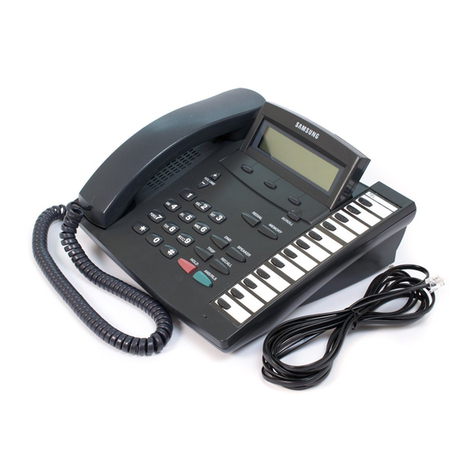
Samsung
Samsung DCS KEYSET user guide

TransTel Communications
TransTel Communications SuperKey SK-824 Features and services description

Vodavi
Vodavi Station user guide

Panasonic
Panasonic KX-T77 Series user guide
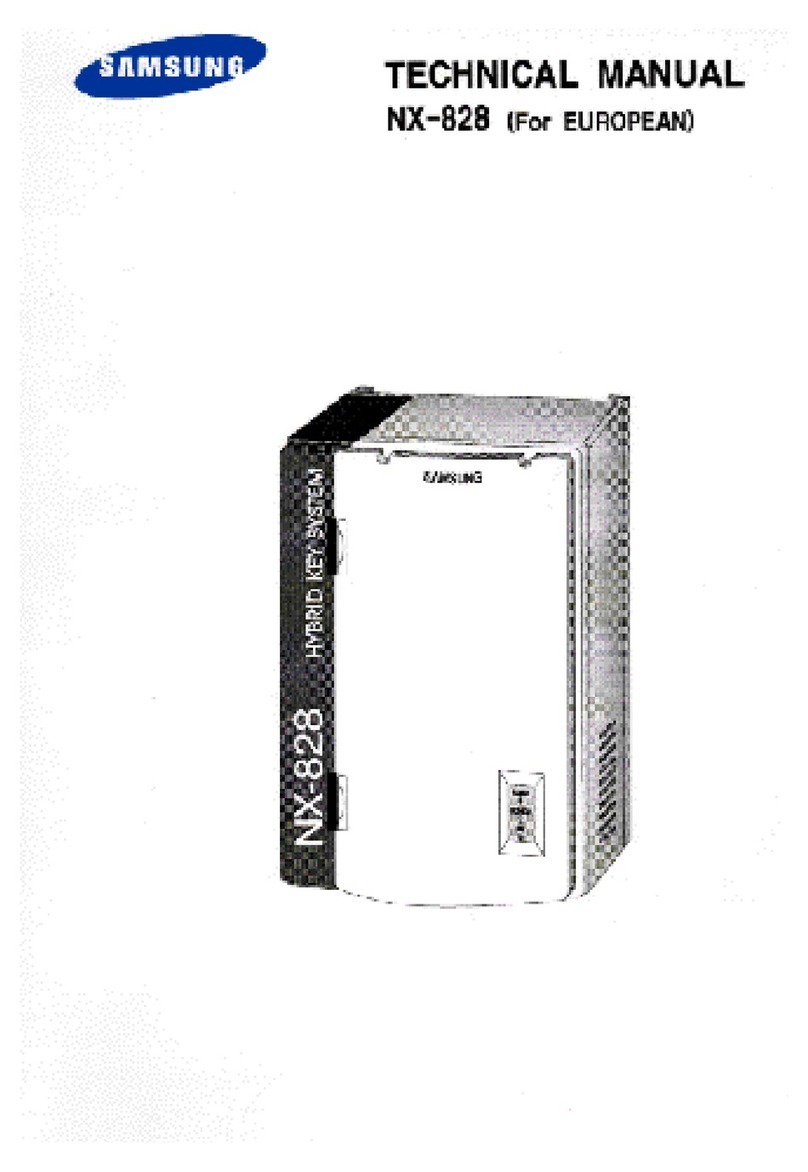
Samsung
Samsung NX-828 Technical manual

Siemens
Siemens Hicom 150 E Office operating instructions

